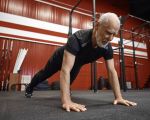- 1. The Importance of Nutrition and Fitness for Long-Term Health
- 2. Building a Sustainable Nutrition Plan
- 3. Crafting a Fitness Routine for Lasting Results
- 4. How Nutrition and Fitness Work Together
- 5. Long-Term Benefits of a Balanced Lifestyle
- 6. Real-Life Examples of Successful Nutrition and Fitness Journeys
- 7. Final Thoughts on Sustaining Health for Life
1. The Importance of Nutrition and Fitness for Long-Term Health
Maintaining long-term health involves more than just the absence of illness; it’s about cultivating a lifestyle that enhances your physical, mental, and emotional well-being for years to come. Nutrition and fitness play pivotal roles in this holistic approach to health. Whether you’re aiming for weight management, improved strength, better cardiovascular health, or enhanced mental clarity, both proper nutrition and consistent physical activity are key contributors to your success. This is why focusing on a balanced combination of healthy eating and regular exercise is essential for sustaining health over the long term.
It’s not about following fleeting diet trends or engaging in extreme workouts for short-term results. Instead, it’s about adopting habits that promote your well-being day in and day out. In this article, we’ll explore how nutrition and fitness are integral to long-term health, offer strategies for developing sustainable practices, and highlight the many benefits of a well-rounded, healthy lifestyle.
2. Building a Sustainable Nutrition Plan
Nutrition is the foundation of any long-term health plan. The foods you eat not only provide the energy and nutrients your body needs but also affect your mood, immune function, and overall health. To achieve lasting health benefits, it’s crucial to adopt a sustainable and balanced nutrition plan that aligns with your lifestyle and goals. Below are key strategies to help you build a nutrition plan that works for the long haul:
1. Prioritize Whole, Nutrient-Dense Foods
One of the best ways to fuel your body for long-term health is to focus on whole, unprocessed foods that are rich in essential nutrients. These foods include fruits, vegetables, lean proteins, whole grains, and healthy fats. Nutrient-dense foods provide more vitamins, minerals, and antioxidants, which support your immune system, reduce inflammation, and promote overall wellness.
2. Embrace a Balanced Diet
While some diets emphasize cutting out certain food groups, a balanced diet that includes a variety of foods is essential for long-term health. A balanced diet ensures that you get all the nutrients your body needs, including carbohydrates, proteins, fats, vitamins, and minerals. Aim to fill your plate with a wide range of colorful vegetables, whole grains, lean protein sources, and healthy fats for a diverse and well-rounded approach to nutrition.
3. Focus on Portion Control
Even healthy foods can contribute to weight gain if consumed in excess. Portion control is crucial to maintaining a healthy weight and preventing overeating. Pay attention to serving sizes, and consider using smaller plates or measuring out portions to avoid consuming too much. This strategy can help you enjoy a variety of foods without overloading your system with excess calories.
4. Stay Hydrated
Proper hydration is often overlooked but is vital for overall health. Water supports digestion, nutrient absorption, temperature regulation, and even joint health. Aim to drink at least eight glasses of water a day, and more if you're engaging in physical activity or living in a hot climate. Incorporating water-rich foods like fruits and vegetables into your diet can also help keep you hydrated.
3. Crafting a Fitness Routine for Lasting Results
Fitness is the other cornerstone of long-term health. Regular physical activity not only enhances physical fitness but also improves mental health, boosts energy levels, and helps maintain a healthy weight. To achieve lasting results, it's essential to create a fitness routine that you can stick to over time. Here’s how you can design a sustainable fitness plan that delivers long-term benefits:
1. Set Realistic Goals
Setting realistic and achievable fitness goals is the first step in creating a sustainable workout routine. Whether your goal is to run a 5K, build muscle, or increase flexibility, make sure your goals are specific, measurable, and attainable. Break down larger goals into smaller, more manageable steps to stay motivated and on track.
2. Incorporate Variety into Your Routine
Doing the same workout day in and day out can lead to boredom and plateaus. To keep things interesting and challenge different muscle groups, incorporate a variety of exercises into your fitness routine. This can include strength training, cardio, yoga, swimming, and even activities like hiking or dancing. A varied routine helps prevent burnout and keeps you engaged over the long term.
3. Focus on Consistency
Consistency is key to achieving long-term fitness goals. Rather than focusing on intense workouts that you can’t sustain, aim for consistent, moderate activity that fits seamlessly into your lifestyle. Aim for at least 150 minutes of moderate-intensity aerobic activity per week, along with two or more days of strength training. By making fitness a regular part of your routine, you’ll reap the benefits of improved health and increased energy.
4. Listen to Your Body
It’s important to pay attention to how your body responds to exercise. Pushing yourself too hard can lead to injuries or burnout, so be sure to listen to your body’s signals. Incorporate rest days into your fitness routine to allow for recovery and muscle repair. Over time, you’ll find the right balance of intensity and recovery that works for your body and fitness goals.
4. How Nutrition and Fitness Work Together
Nutrition and fitness are two sides of the same coin when it comes to achieving long-term health. The foods you eat provide the fuel and nutrients necessary for your body to perform physical activities, recover from workouts, and build muscle. On the flip side, regular exercise increases your body’s demand for nutrients, particularly protein, healthy fats, and carbohydrates. Here’s how nutrition and fitness complement each other:
1. Fueling Workouts
Before and after exercise, your body needs fuel to perform at its best. Consuming a balanced meal or snack before your workout provides the energy needed to power through your routine, while eating the right foods after exercise supports muscle recovery and replenishes glycogen stores. A combination of protein and carbohydrates is ideal for post-workout recovery, helping to repair muscles and promote growth.
2. Building Muscle and Strength
If your goal is to build muscle or increase strength, proper nutrition is crucial. Protein is the building block of muscle, and adequate intake is essential for muscle repair and growth. Pairing regular strength training with a protein-rich diet can help maximize your results. Healthy fats and carbohydrates also provide energy for more intense workouts, enabling you to push harder and achieve your fitness goals.
5. Long-Term Benefits of a Balanced Lifestyle
When you combine consistent nutrition and fitness habits, the benefits extend far beyond just physical appearance. A balanced lifestyle offers numerous advantages for both short-term and long-term health:
1. Weight Management
A balanced diet and regular exercise help regulate weight and prevent obesity. By maintaining a healthy weight, you reduce the risk of developing chronic conditions such as heart disease, diabetes, and hypertension.
2. Enhanced Longevity
Living a healthy lifestyle can extend your life expectancy by reducing the risk of developing age-related diseases. Nutrition and fitness can improve cardiovascular health, increase bone density, and maintain cognitive function, contributing to a longer, healthier life.
3. Better Mental Health
Physical activity has a direct impact on mental well-being. Regular exercise releases endorphins, which help reduce stress, anxiety, and symptoms of depression. Coupled with a nutrient-rich diet, a balanced lifestyle can enhance mood, boost mental clarity, and promote overall mental health.
6. Real-Life Examples of Successful Nutrition and Fitness Journeys
Real-life stories can offer valuable insights into the power of nutrition and fitness. For example, Sarah, a 35-year-old working professional, struggled with energy levels and weight gain for years. After adopting a sustainable nutrition plan focused on whole foods and beginning a regular fitness routine, she lost 25 pounds and gained significant muscle tone. More importantly, she felt more energized and less stressed in her daily life. Her journey shows how small, consistent changes can result in long-term health improvements.
7. Final Thoughts on Sustaining Health for Life
Nutrition and fitness are not one-time fixes—they are lifelong commitments that contribute to your overall well-being. By focusing on sustainable, balanced nutrition and regular exercise, you can enjoy a higher quality of life, better health outcomes, and greater longevity. The key is consistency and finding a routine that works for your body and lifestyle. If you’re looking for guidance on starting your own wellness journey, consider checking out Fitness for the best products, services, and advice to help you achieve lasting health and well-being.








